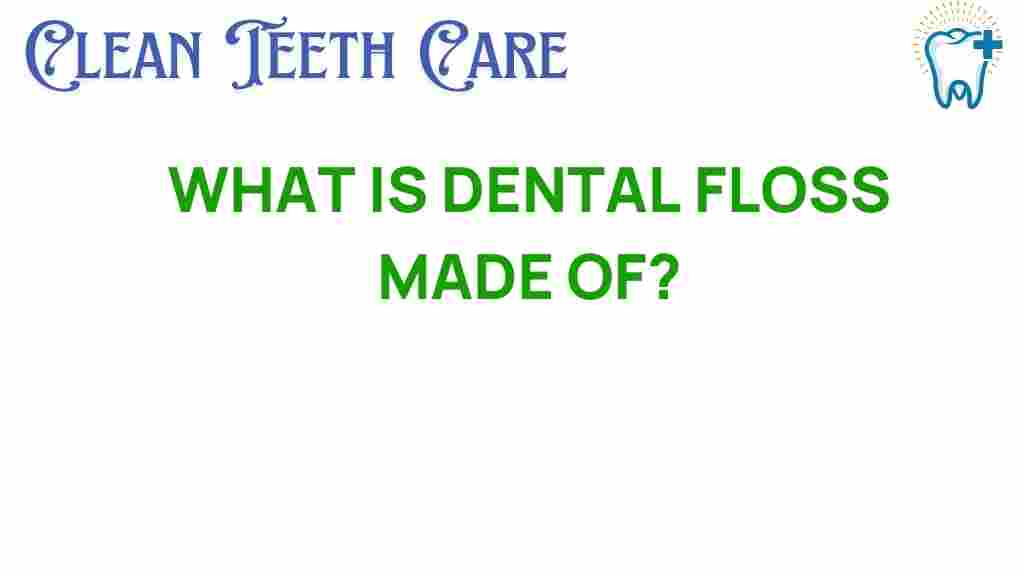Unraveling the Mystery: What Is Dental Floss Made Of?
When it comes to oral hygiene, dental floss is often overlooked, yet it plays a crucial role in maintaining our overall dental health. While we frequently hear about the importance of brushing our teeth, flossing is equally vital for preventing gum disease and cavities. In this article, we will explore what dental floss is made of, the different types available, their health benefits, eco-friendly options, and usage tips to optimize your dental care routine.
Understanding Dental Floss Materials
Dental floss is specifically designed to clean between teeth and remove plaque and food particles that a toothbrush can’t reach. But what exactly is dental floss made of? The materials used in dental floss can vary, impacting its effectiveness and user experience. Below, we outline the primary materials found in dental floss:
- Nylon: The most common type of dental floss, nylon is made from multiple strands woven together to create a strong yet flexible product. It is available in waxed and unwaxed varieties.
- PTFE (Polytetrafluoroethylene): This material is often found in high-end dental floss. PTFE is a single filament that glides easily between teeth and is less likely to shred.
- Silk: An eco-friendly option, silk floss is biodegradable and made from natural silk fibers. It is often coated with natural wax for ease of use.
- Fluoride-coated floss: Some dental floss options come infused with fluoride, which can provide additional protection against cavities.
Why Materials Matter
The choice of material can affect how well the floss performs. For instance, nylon floss is more prone to shredding, especially if you have tight contacts between your teeth. PTFE floss, on the other hand, is stronger and slides more smoothly, making it suitable for those with tighter spaces. Choosing the right material is essential for effective oral hygiene.
Health Benefits of Using Dental Floss
Regularly using dental floss offers numerous health benefits, particularly for your oral hygiene. Here are some key advantages:
- Prevention of Gum Disease: Flossing helps remove plaque and food particles that can lead to gingivitis and other gum diseases.
- Reduced Risk of Cavities: By cleaning between the teeth, flossing decreases the chances of cavities forming in hard-to-reach areas.
- Improved Breath: Regular flossing helps eliminate odor-causing bacteria trapped between teeth.
- Overall Health Benefits: Studies have linked poor oral hygiene to various health issues, including heart disease and diabetes. Maintaining good oral hygiene through flossing can contribute to better overall health.
Types of Floss: Finding Your Perfect Match
There are several types of dental floss available, each designed to cater to different preferences and needs. Understanding these options will help you choose the right one for your oral care:
- Waxed vs. Unwaxed: Waxed floss is coated in wax, making it easier to slide between teeth, while unwaxed floss is thinner and can fit into tighter spaces.
- Flavored vs. Unflavored: Flavored floss can make the experience more pleasant, especially for children, while unflavored options are often preferred by adults.
- Thick vs. Thin: Thick floss is suitable for wider gaps, while thin floss works better for tight spaces.
- Dental Tape: Wider than traditional floss, dental tape is especially beneficial for those with larger gaps between their teeth.
Eco-Friendly Options
As awareness of environmental issues grows, many are seeking eco-friendly dental floss options. Here are some sustainable alternatives:
- Biodegradable Floss: Look for floss made from natural materials like silk or plant-based fibers that break down easily.
- Refillable Floss Containers: Some brands offer refillable options, reducing plastic waste.
- Plastic-Free Floss: Brands are increasingly producing floss without plastic components, focusing on sustainability.
Choosing eco-friendly dental floss not only benefits your oral hygiene but also helps reduce your environmental footprint. For more information on sustainable oral care products, visit this resource.
Usage Tips for Effective Flossing
Using dental floss correctly is essential to maximize its effectiveness. Here are some tips for proper flossing:
- Use Enough Floss: Cut about 18 inches of floss to give you enough length to wrap around your fingers, allowing for a clean section for each tooth.
- Be Gentle: Slide the floss gently between your teeth. Do not force it, as it can cause damage to your gums.
- Curve the Floss: When you reach the gum line, curve the floss into a C shape against one tooth and slide it under the gum line. Repeat on the adjacent tooth.
- Floss Regularly: Aim to floss at least once a day for optimal results.
Troubleshooting Common Flossing Issues
Despite the importance of dental floss, some individuals may encounter issues while flossing. Here are common problems and solutions:
- Shredding Floss: If your floss shreds between teeth, consider switching to a PTFE or thicker floss that is designed to resist fraying.
- Bleeding Gums: If your gums bleed when you floss, it may be a sign of gum disease. Consult your dentist if this persists.
- Tight Spaces: If your teeth are tightly spaced, try using waxed floss or dental tape to navigate the gaps more easily.
Conclusion: Elevate Your Dental Care Routine
Understanding what dental floss is made of and its various types can greatly enhance your oral hygiene routine. With the health benefits of regular flossing, including the prevention of gum disease and cavities, there’s no excuse for neglecting this essential step in your dental care regimen. Additionally, considering eco-friendly options allows you to maintain great oral health while being kind to the environment.
Make flossing a part of your daily routine and follow the usage tips provided to ensure your technique is effective. For further information on dental care practices, you can explore additional resources like Dental Care.
Now that you know what dental floss is made of and how to use it effectively, it’s time to take control of your oral hygiene. Happy flossing!
This article is in the category Hygiene and created by CleanTeethCare Team
